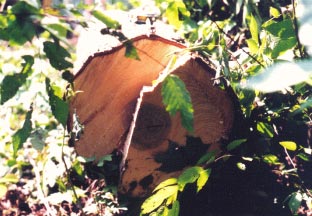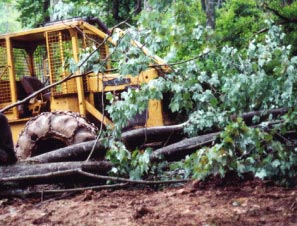
Case: 02WV018-01
Release Date: February 7, 2003
Timber Cutter Dies After Being Struck by the Tree He Was Felling in West Virginia
SUMMARY
On July 4, 2002, a 48-year-old male tree feller (the victim) died of injuries sustained when he was struck by the tree he was felling. The tree, with a slight up-hill lean, was located approximately 10 feet down hill from a skid road. It was 15 inches in diameter at breast height (DBH) and 90 feet tall. At the time of the incident, a skidder had been parked above the tree on the skid road. The victim had not cleared an escape path. He began cutting the tree with the intention of felling the tree in a downhill direction. The victim did not use a notch, hinge, or wedge. As he finished his final cut, the tree set-back and began falling uphill. When the victim started to retreat uphill, his foot became tangled in brush. As he freed himself, the falling tree struck the skidder, bounced off, and subsequently struck him, causing extensive upper body damage. Witnessing the incident, his partner responded by running down the hill to the nearest house. The homeowner called 911 and waited to direct the ambulance. The co-worker returned to the incident site to comfort the victim who remained conscious. Approximately 30 minutes passed from the time the incident took place until the EMS arrived. The victim died shortly after their arrival and was transported to the nearest medical facility where he was pronounced dead.
The WV FACE Investigator concluded that, to reduce the likelihood of similar occurrences, employers should:
INTRODUCTION
On July 4, 2002, a 48-year-old male tree feller (the victim) died of injuries sustained when he was struck by the tree he was felling. On July 9, 2002, the West Virginia FACE Investigator was notified of the death by the West Virginia Division of Forestry (WVDOF). The incident was reviewed with the WVDOF representative, who then accompanied the Investigator to the site where an investigation was conducted on August 23, 2002. The victim's partner, who witnessed the incident, was interviewed. The incident site was examined and photographed. Other informational sources and contacts included: death certificate, medical examiner's report, newspaper articles, WVDOF, and OSHA.
The logging operation was a non-structured partnership. The victim and the witness had operated this way for approximately 4 years cutting saw timber and fire wood for resale. They had no employees. The operation was illegal from the stand point of not having a West Virginia Business License. The land was privately-owned.
Neither partner held Certified Logger status in West Virginia and therefore they were operating without a current timber license. Additionally, the operation was being run without the required DOF applications and subsequent approvals. [Note: The Logging Sediment Control Act of West Virginia (1992) requires that each timbering operation in West Virginia be supervised by a certified logger. To become a certified logger, an individual is required to successfully complete training and pass a test for best management practices (a soil erosion prevention plan) and chain saw safety as well as possess a current first aid card.1]
There was no written safety program and a company safety officer had not been designated. The victim's partner did not indicate that formal company-specific training was provided. It was reported that each man was responsible for his own safety. The victim had experienced similar logging related near misses and injuries over the past four years.
The victim's job at the time of the incident was felling trees. He had been a felling timber for at least twenty five years. It was reported he did not agree with regulatory intervention concerning forest utilization and occupational safety. Specifically, he expressed to his partner that he did not accept OHSA's tree felling requirements and would not attend the WVDOF's chainsaw safety workshop or other formal safety-related training programs. At the time of the incident, the victim was not wearing a hard hat, eye protection, hearing protection, chaps or chainsaw resistant boots This was the first tree he attempted to cut that day.
INVESTIGATION
On July 4, 2002, a 48-year-old male tree feller (the victim) died of injuries sustained when he was struck by the tree he was felling. He was in the process of felling a maple tree which was approximately 15 inches DBH and 90 feet tall. The tree had a slight up-hill lean and was located approximately 10 feet down hill from a skid road. At the time of the incident, a skidder had been parked above the tree on the skid road. Just prior to cutting the tree, the victim's partner expressed concern about the tree's uphill lean and offered to assist him in directing it downhill. The victim did not accept the partner's offer. It was reported his cutting was done in haste. The victim did not clear an escape path and there were branches obstructing the most sensible retreat direction. He began cutting the tree with the intention of felling the tree in a downhill direction. The victim did not use a notch, hinge, wedge, or other directing measures to fell the tree (see Figure 1). As he finished the final cut, the tree set-back and began falling uphill. When the victim started to retreat uphill at a slight angle to the tree's fall path, his foot became tangled in branches and brush. As he freed himself, the falling tree struck the skidder, bounced off, and subsequently struck the victim, causing extensive upper body damage (see Figure 2). Upon witnessing the incident, his partner ran down the hill to the nearest house. The homeowner called 911 and waited to direct the ambulance. The co-worker returned to the incident site to comfort the victim who though conscious, was expressing paralysis and difficulty in breathing. Approximately 30 minutes passed from the time the incident took place until the EMS arrived. The victim died shortly after their arrival and was transported to the nearest medical facility where he was pronounced dead.
CAUSE OF DEATH
The medical examiner's report listed the immediate cause of death as multiple blunt force traumatic injuries.
RECOMMENDATIONS/DISCUSSION
Recommendation #1: Employers should ensure that tree fellers utilize proper directional felling techniques.
Discussion: Directional felling is the safest manual felling method of getting trees on the ground. The proper notch directs the tree's fall and the hinge wood keeps the tree under control as it falls. CFR 1910.266h(2)(v) requires that a directional undercut be made or face notch, and 1910.266h(2)(vi) requires that a back cut be made leaving sufficient hinge wood to hold the tree to the stump during most of its fall so the hinge is able to guide the tree's fall in the intended direction.2 The West Virginia Logger's Safety Field Guide also recommends the use of proper directional felling techniques.3 The victim did not utilize directional felling techniques. All control over felling direction is lost if there is no notch or hinge wood. Having established a proper face notch as well as the proper amount of hinge wood, may have ensured that the tree would have fallen in its intended down hill direction.
Recommendation #2: Employers should ensure that tree fellers utilize felling wedges in addition to proper felling techniques on trees with back lean.
Discussion: Trees with moderate back lean should be wedged to fall in the desired direction. After establishing an open faced notch and determining the required amount of hinge wood, the feller should begin the back cut. As soon as the back cut is deep enough, a wedge should be driven into the cut. The back cut should continue leaving a hinge at least 1/10 the tree's diameter. When the back cut is complete the tree should start to fall. If not, felling may be aided by driving the wedge further into the cut. Having learned and implemented the use of wedges to safely fell trees with back lean may have ensured that the tree would have fallen in its intended down hill direction.
Note: When using the bore cut and release, the wedge should be driven into the chainsaw cut on the side of the release tab which has the tree's weighted side lean (bad side).
REFERENCES
ILLUSTRATIONS

Figure l. The photo shows the butt of the felled tree.
Note the lack of notch and hinge wood as well as the by-pass cut.
The segmented arrow represents the intended direction of fell.
The solid arrow represents the actual direction of fell.

Figure 2. The photo shows tree which struck the victim and the skidder which it bounced off of.
The white arrow represents the intended direction of fell.
FATALITY ASSESSMENT AND CONTROL EVALUATION PROGRAM
The WVU Center for Rural Emergency Medicine, through a contract with the West Virginia Department of Health and Human Resources and Bureau for Public Health, conducts investigations on the causes of work-related fatalities within the state. The goal of this program is to prevent future fatal workplace injuries. West Virginia FACE intends to achieve this goal by identifying and studying the risk factors that contribute to workplace fatalities, by recommending intervention strategies, and by disseminating prevention information to employers, employees, trade associations, unions, equipment manufacturers, students, teachers, and others with an interest in workplace safety.
Please use information listed on the Contact Sheet on the NIOSH FACE website to contact In-house FACE program personnel regarding In-house FACE reports and to gain assistance when State-FACE program personnel cannot be reached.